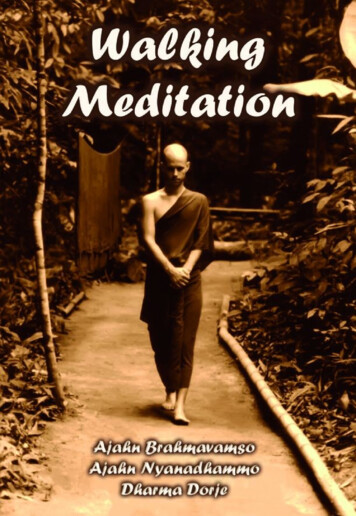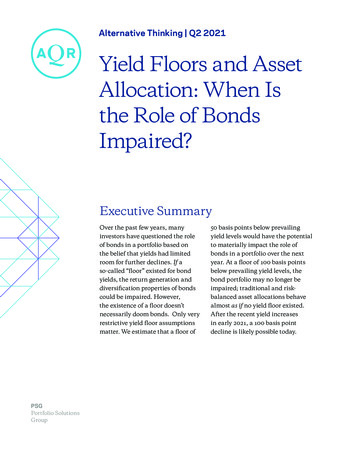
Transcription
WALKING MEDITATIONTHREE EXPOSITIONS ON WALKING MEDITATIONbyAjahn Ñāṇadhammo,Ajahn Brahmavaṃso,andDharma Dorje
Buddhist Publication SocietyP.O. Box 6154 Sangharaja MawathaKandy, Sri Lankahttp://www.bps.lkFirst BPS edition: 2007Editorial matter (c) BPS 2007, 2016(Copyright of the individual essays with the authors)ISBN : 978-955-24-0300-2National Library of Sri Lanka–Cataloguing inPublication DataNyanadhammo, AjahnWalking meditation ; Three Expositions on WalkingMeditation/ Ajahn Nyanadhammo, Ajahn Brahmavamso and Dharma Dorje. - Kandy: Buddhist Publication Inc., 2007. p.66; 18cm.ISBN : 978-955-24-0300-2Price:i. 294.34435 DDC 22ii. Titleiii. Brahmavamso, Ajahn -jt.au.iv. Dorje, Dharma - jt.au.I. Meditation2. BuddhismTypeset at the BPS in GaramondNo8BPSPrinted byBalin Printing Services (Pvt) Ltd.,Kandy
ContentsAbout the Essays . vAbout the Authors . vDiscourses .viWALKING MEDITATION IN THETHAI FOREST TRADITIONThe Five Benefits of Walking Meditation . 3Developing Endurance for Walking Distances . 3Good for Striving . 4Good for Health . 5Good for Digestion . 5Good for Sustaining Concentration . 5Preparation for Walking Meditation . 7Finding a Suitable Place . 7Preparing the Body and Mind . 8Meditation Objects for Walking Meditation . 9Awareness of the Walking Posture . 9From Sitting Meditation to the Walking Path . 13Choosing a Mantra . 14Contemplation of the Way Things Are . 15Investigating Impermanence . 15Recollecting Generosity and Virtue . 16Recollecting the Nature of the Body . 17Other Contemplations . 19Wise Use of Contemplation . 19Conclusion . 21
WALKING MEDITATION IS WONDERFULSetting Up Walking Meditation .23The Stages of Meditation Apply Here Too .23Samādhi on the Walking Path .25WALKING MEDITATION PRACTICESAttitudes and Perceptions .29Walking by Itself .30Enhancing the Practice .35Further Guidelines .38Walking Between Sits during Retreats .39Insight Walking .41Changing the Insight Walk .51A Gentle Shift from Insight Walking .52Tranquillity Walking .56Benefits of the Practice .59End Notes 61Bibliography 66
About the Essays“Walking Meditation in the Thai Forest Tradition” byAjahn Nyanadhammo was edited from two Dhammatalks given at Dhammaloka Buddhist Centre (31st ofJuly, 1992) and Bodhinyana Forest Monastery (22nd ofJanuary 2002), Perth, Australia. It was published privately by Wat Pah Nanachat and is republished herewith the kind permission of the author.“Walking Meditation is Wonderful” by Ajahn Brahmavaṃso is an extract (pp. 74–78) from Mindfulness,Bliss, and Beyond, Boston, 2006, used with the permission of Wisdom Publications.The essay “Walking Meditation Practices” byDharma Dorje (Michael Bell) is first published here.About the AuthorsVenerable Ajahn Ñāṇadhammo, of Australian nationality, is the abbot of Wat Pah Nanachat, the InternationalForest Monastery in Thailand.Venerable Ajahn Brahmavaṃso, of British-Australian nationality, is the abbot of Bodhinyana Monastery,Western Australia. He is a popular meditation teacherand the author of Mindfulness, Bliss and Beyond, fromwhich this extract has been taken.Dharma Dorje, a.k.a. Michael Bell (1956–2015), ofCanadian nationality, was the son and pupil of the lateKema Ananda, the first teacher at the Arrow RiverCommunity Centre, now Arrow River Forest Hermitage, near Thunder Bay, Canada.
DiscoursesBhikkhus, there are these five benefits in walking meditation. What five? One endures long (walking) journeys. One endures striving (in meditation). One haslittle physical afflictions. What is eaten, drunk, chewed,tasted, is well digested. The concentration that has beenattained by walking meditation lasts for a long time.(AN 5:29)“. Moggallāna, perceiving what is before and behind1,you should fix attention on walking meditation, withthe sense-faculties turned inward, and the mind notgoing out. ”(AN 7:58)“Bhikkhus, you should train thus: ‘We will be devotedto wakefulness; by walking and sitting meditation during the day, night, we will purify our minds ofobstructive states.’”(MN 39.10)I left my dwelling overcome by sleepiness. Going ontothe walking path, I fell down on the earth.Having rubbed my limbs and having gone onto thewalking-meditation path again, I did walking meditation and became well composed in mind.Then wise attention arose in me, the danger inexistence became clear, disenchantment was established,and my mind was released.(Bhagu Thera, Theragāthā 271–273)
Walking Meditation in theThai Forest TraditionByAjahn ÑāṇadhammoThis discourse addresses the how, when, where andwhy of walking meditation. It includes both practicalinstructions of the technical aspects of walking meditation and instructions for creating the quality of mindthat leads to concentration, insight and wisdomthrough the physical activity of walking meditation.The Buddha stressed developing mindfulness in thefour main postures of the body: standing, sitting, lyingdown and walking. He exhorted us to be mindful in allthese postures, to create a clear awareness and recollection of what we are doing while we are in any particularposture.Walking meditation is called caṅkama in Pali. If youread about the lives of the monks and nuns at the timeof the Buddha, you will see that many obtained thestages of Enlightenment while on the walking meditation path. Walking meditation is an activity in whichone can focus and concentrate the mind or developinvestigative knowledge and wisdom.Some people find that they are naturally drawn towalking meditation because they find it easier and morenatural than sitting meditation. When they sit they feeldull, or tense, or they are easily distracted. Their minddoesn’t calm down.
2Walking MeditationIf this is the case with you, don’t just persevere; try achange of posture or do something new. Experimentwith standing meditation or try walking meditation.This new meditation posture may give you some otherskilful means of applying the mind. All of the four postures of meditation are just techniques, methods fordeveloping and training the mind. Try and develop walking meditation; you may start to see the benefits of it.In the Forest Meditation Tradition in NortheastThailand, there is a great emphasis on walking meditation. Many monks will walk for long hours as a way ofdeveloping concentration, sometimes as much as ten orfifteen hours a day!The late Ajahn Singtong used to do so much walking meditation that he would make a rut in the walkingpath. The sandy path that he used for walking meditation would actually become hollow because he wouldwalk so many hours in a day. Another monk, AjahnKum Dtun wouldn’t bother to go into his hut at night.When he became really tired after walking in meditation all day and late into the night, he would lay downright there on the meditation path and use his fist as apillow. He would go to sleep with mindfulness, havingmade a determination to get up the moment he woke.As soon as he woke, he would start walking again. Hebasically lived on his walking meditation path! AjahnKum Dtun was quick to attain results in his practice.In the West, there is not such an emphasis on thepractice of walking meditation. Thus I would like todescribe the process and recommend it to you to complement your sitting practice. I hope these instructions
Walking Meditaton in the Thai Forest Tradition3will help you develop your repertoire of meditativetechniques—in both formal meditation and in yourdaily life. As so much of life is taken up with the activity of walking, if you know how to apply awareness toit then even simply walking about in your house canbecome a meditation exercise.The Five Benefits of Walking MeditationThe Buddha spoke of five benefits of walking meditation. In the order that he listed them in this Sutta (seefrontispiece), they are as follows: walking meditationdevelops endurance for walking long distances; it isgood for striving; it is healthy; it is good for the digestion after a meal, and the concentration won fromwalking meditation lasts a long time.Developing Endurance for Walking DistancesThe first benefit of walking meditation is that it leads toendurance in walking distances. This was particularlyimportant at the time of the Buddha when most peopletravelled by foot. The Buddha himself would regularlygo wandering from place to place, walking up to sixteenkilometres a day. So he recommended that walkingmeditation be used as a way of developing physical fitness and endurance for walking long distances.Forest monks these days still go wandering; it iscalled tudong in Thai. They take their bowls and robesand walk, seeking out secluded places to meditate. Inpreparation for wandering, they progressively increase
4Walking Meditationthe amount of walking meditation so as to develop theirphysical fitness and endurance. They increase the number of hours of walking meditation a day to at least fiveor six hours.Good for StrivingStriving, especially to overcome drowsiness, is the second benefit. While practising sitting meditation, meditators may slip into tranquil states, but if they are “tootranquil,” they may start nodding off to sleep. Withoutmindfulness and awareness, meditation, even though itfeels peaceful, can turn into dullness because it has beenovercome by sloth and torpor. Doing walking meditation can counteract this tendency.Ajahn Chah used to recommend us that once aweek we stay up all night, sitting and doing walkingmeditation throughout the night. We tended to get verydrowsy around one or two in the morning, so AjahnChah recommended we do the walking meditationbackwards to overcome drowsiness. You don’t fallasleep walking backwards!Once at Bodhinyana Monastery in Western Australia, I went out early one morning, around five o’clock,to do some walking meditation and saw a layman, whowas staying for the Rains Retreat in the monastery,doing walking meditation up and down along the top ofthe six-foot high wall in front of the monastery. By putting great effort into being mindful of each step, he wasovercoming drowsiness by developing a heightenedsense of alertness, effort and zeal.
Walking Meditaton in the Thai Forest Tradition5Good for HealthThe Buddha said that walking meditation leads to goodhealth. This is the third benefit. We are all aware thatwalking is considered a very good form of exercise.These days, we even hear of “power walking”. Well, weare talking here about “power meditation,” developingwalking meditation as both a physical and mental exercise. But to get both benefits, we have to bring awareness to the process of walking, instead of just walkingand letting the mind wander off thinking of otherthings.Good for DigestionThe fourth benefit of walking meditation is that it isgood for the digestion. This is particularly importantfor monks who eat one meal a day. After a meal, theblood goes to the stomach and away from the brain.Thus one can feel drowsy. Forest monks stress thatafter a meal one should do a few hours of walking meditation, because walking up and down helps the digestion. For lay meditators too if you have had a heavymeal, instead of going to bed, go out and do an hour ofwalking meditation. It will help with physical wellbeing and provide an opportunity to cultivate the mind.Good for Sustaining ConcentrationThe fifth important benefit of walking meditation isthat the concentration arising out of walking medita-
6Walking Meditationtion sustains itself for a long time. The walking postureis a relatively coarse or complex meditative posturecompared to sitting. While sitting, it is easy to maintainone’s posture. We have our eyes closed so there are novisual sense stimuli, and we are not engaged in anybodily movement. So sitting, in comparison to walking,is a simpler posture in terms of the activities involved.The same is true for standing and lying down, becausethere is no movement taking place.If one has developed concentration only in the sitting posture, when one gets up from that position andbegins with bodily movements like walking, it is harderto maintain that state of concentration. This is becauseone is moving from a refined state to a coarser state.While we are walking there is much more sensoryinput. We are looking where we are going; thus there isvisual input. There is also sensory input from the movement of the body. Therefore if we can concentrate themind while walking and receiving all this sensory stimuli, then when we change from that posture to a simpler one, concentration becomes easier to maintain.That is, when we sit down the strength of mind andpower of that concentration carries over easily to thisposture. So walking meditation can help to developstrength and clarity of mind, and a concentration thatcan carry over into other less active meditation postures.
Walking Meditaton in the Thai Forest Tradition7Preparation for Walking MeditationFinding a Suitable PlaceThe place where the Lord Buddha did walking meditation at Bodhgaya after his Enlightenment still exists tothis day. His walking path was seventeen steps long.These days the Forest Monks tend to make their walking meditation paths much longer — up to thirty stepslong. The beginner may find thirty paces too longbecause their mindfulness has not yet developed. By thetime you come to the end of the path, your mind mayhave been “around the world and back.” Remember,walking is a stimulating posture, and initially the mindtends to wander a great deal. It is usually better forbeginners to start off on a shorter path; fifteen paceswould be a good length.If you do a walk meditation outside, find a secludedplace where you won’t be distracted or disturbed. It isgood to find a walking path that is slightly enclosed. Itcan be a distraction to walk in an open area where thereis a view, as you may find that the mind is drawn out tothe scenery. If the path is closed in, it tends to bring themind inwards, into one’s self and towards peace. Anenclosed area is especially suitable for speculative personalities who like to think a lot; it helps to calm theirminds.2
8Walking MeditationPreparing the Body and MindOnce you have chosen a suitable path, stand at one end.Stand erect. Put the right hand over the left in front ofyou. Don’t walk with your hands behind your back. Ameditation master who visited the monastery where Iwas staying once commented when he saw one of theguests walking up and down with his hands behind hisback: “He’s not walking meditation; he’s going for astroll.” By placing the hands in front, it creates a cleardetermination to focus the mind on walking meditation, to differentiate from “just walking.”The practice is firstly to develop samādhi, a Paliword that means focussing the mind, developing themind to one-pointedness by gradual degrees of mindfulness and concentration. To focus the mind, one has tobe diligent and determined. This requires a degree ofphysical as well as mental composure. One begins bycomposing oneself by clasping the hands in front. Composing the body helps to compose the mind. Havingthus composed the body, one should then stand stilland bring awareness and attention to the body. Thenraise your hands together in añjali, a gesture of respect,and with your eyes shut reflect for a few minutes on thequalities of the Buddha, the Dhamma and the Saṅgha(buddhānussati, dhammānussati and saṅghānussati).Contemplate having taken refuge in the Buddha,the Wise One, He who Knows and Sees, the AwakenedOne, the Fully Enlightened One. Reflect in your hearton the qualities of the Buddha for a few minutes. Thenrecall the Dhamma—the Truth that you are striving to
Walking Meditaton in the Thai Forest Tradition9realize on the walking meditation path. Finally, bringto mind the Saṅgha, especially those fully EnlightenedOnes who have realized the Truth by cultivating meditation.Then bring the hands down in front of you andmake a mental determination on how long you aregoing to “walk meditation’, be it half an hour, onehour, or more. However long you determine to walkfor, adhere to it. In this manner you are nurturing themind at that initial stage of the meditation with zest,inspiration and confidence.Meditation Objects forWalking MeditationThe Buddha taught forty different meditation objects,3many of which can be used on the walking path. However some are more suitable than others. I shall discuss anumber of these meditation objects here, beginningwith those most commonly used.Awareness of the Walking PostureThe first method is awareness of the walking posture.While walking, place all your attention at the soles ofthe feet, on the sensations and feelings as they arise andpass away. As you walk, the feeling will change. As thefoot is lifted and comes down again into contact withthe path, a new feeling arises. Be aware of this sensationon the sole of the foot. Again as the foot lifts, mentally
10Walking Meditationnote the new feeling as it arises. When you lift each footand place it down, know the sensations felt. At eachnew step, certain new feelings are experienced and oldfeelings cease. These should be known with mindfulness. With each step there is a new feeling experienced—feeling arising, feeling passing away; feeling arising, feeling passing away.With this method, we place mindfulness on the feeling of walking itself, on each step taken, on the vedanā(pleasant, unpleasant or neutral sensations). We areaware of whatever type of vedanā arises at the soles ofthe feet. When we stand, there is a sensation, a feeling,of the contact with the ground. This contact can produce pain, heat or other sensations. We place our mindful attention on those feelings, knowing them fully.When raising the foot to take a step, the feeling changesas soon as the foot loses contact with the ground. Whenwe place that foot down, again a new feeling arises asthe foot comes into contact with the ground. As wewalk, feelings are constantly changing and arising anew.We mindfully note this arising and passing away of feelings as the soles of the feet lift off or touch onto theground. In this way we are keeping our full attentionjust on the sensations that arise through walking.Have you ever really noticed before the feelings inthe feet as you walk? They happen every time we walk,but we tend not to notice these subtle things in life.When we walk, our minds tend to be somewhere else.Walking meditation is a way of simplifying what we aredoing when we are doing it. We are bringing the mindto the “here and now,” being “one with walking when
Walking Meditaton in the Thai Forest Tradition11walking”. We are simplifying everything, quieting themind by just knowing feeling as it is arising and passingaway.It is important to remember when walking to keepthe eyes cast down about a metre and a half in front.Don’t be looking around distracted by this or that.Keep awareness on the feeling at the soles of the feet,and in this way, develop focussed attention, and clearknowing of walking while walking.How fast should you walk? Ajahn Chah recommended walking naturally, not too slow or too fast. Ifyou walk fast, you might find it very difficult to concentrate on the sensation of feeling arising and passingaway. You may need to slow down. On the other hand,some people may need to speed up. You have to findyour own pace, whatever works for you. You can beginslowly at first then gradually come to your normalwalking pace.If your mindfulness is weak (meaning your mindwanders a lot), then walk very slowly until you can stayin the present moment of each step. Start by establishing mindfulness at the beginning of the path. When youarrive in the middle of the path, then mentally askyourself, “Where is my mind? Is it on the feeling at thesoles of the feet? Am I knowing the contact here andnow, at this present moment?” If the mind has wandered off, then bring it back to the sensations at the feetagain and continue walking.When you get to the end of the path, turn slowlyaround and re-establish your mindfulness. Where is themind? Has it wandered off? Does it know the feeling at
12Walking Meditationthe soles of the feet? The mind tends to wander elsewhere chasing thoughts of: anxiety, fear, happiness, sorrow, worries, doubts, pleasures, frustrations and all theother myriad thoughts that can possibly arise. If mindfulness of the meditation object is not present, re-establish the mind on the simple act of walking, and thenbegin to walk back to the other end of the path.When you get to the middle of the path, again note,“I am now at the middle of the path” and check to see ifthe mind is with the object. Then, once you arrive atthe end of the path mentally note, “Where is the mind?”In this way, you walk back and forth mindfully awareof the feelings arising and passing away. While walking,constantly re-establish your mindfulness pulling themind back, drawing the mind inward, becoming aware,knowing the feeling at each moment as it is arising andpassing away.As you sustain mindfulness on the sensations andfeelings at the soles of the feet, you will notice that themind gets less distracted. The mind becomes lessinclined to go out to things that are happening aroundyou. You become calmer. The mind becomes tranquilas it settles down. Once the mind is calm and tranquil,then you’ll find that walking becomes too coarse anactivity for this quality of mind. You will just want tobe still. So stop and stand to allow the mind to experience this calm and tranquillity.Walking involves the mental volition to move, andyour mind may be too focused on the meditation objectto move. Continue the practice in a standing position.Meditation is about the work of the mind, not about
Walking Meditaton in the Thai Forest Tradition13any particular posture. The physical posture is just aconvenient means to enhance the work of the mind.This calmness and tranquillity is known as passaddhi; it is one of the factors of Enlightenment. Concentration and tranquillity work together withmindfulness; combined with the factors of energy,investigation of Dhamma, joy, and equanimity, theymake up the “Seven Factors of Enlightenment.” Whenin meditation the mind is tranquil, then because of thattranquillity there will arise a sense of joy, rapture, andbliss. The Buddha said that the bliss of peace is the highest happiness. A concentrated mind experiences thatpeace, and this peace can be experienced in our lives.Having developed the practice of walking meditation in a formal context, then when we are walkingaround in our daily lives going to the shops, walkingfrom one room to the other, we can use this activity ofwalking as meditation. We can be aware just of walking,simply being with that process. Our minds can be stilland peaceful. This is a way of developing concentrationand tranquillity in our daily lives.From Sitting Meditation to the Walking PathIf while doing sitting meditation, the mind becomestranquil with a certain meditation object, then you canuse that same object in walking meditation. Howeverwith some subtle meditation objects, such as the breath,the mind must have attained a certain degree of stabilityin that calmness first. If the mind is not yet calm andyou begin walking meditation focusing attention on the
14Walking Meditationbreath, it will be difficult, as the breath is a very subtleobject. It is generally better to begin with a coarserobject of meditation, such as the sensations of feelingsarising at the feet.There are many meditation objects that do transferwell from the sitting to the walking posture: for example the Four Divine Abidings: Loving-kindness, Compassion, Appreciative Joy and Equanimity. As you paceback and forth develop the expansive thoughts based onloving-kindness, “May all beings be happy, may allbeings be at peace, may all beings be free from all suffering.” You can use the walking posture as a complementto sitting, developing meditation on the same object butin a different posture.Choosing a MantraIf while walking meditation you find that you are getting drowsy, then activate the mind, rather than calm it,with a mantra so that it becomes more focussed andawake. Use a mantra like Buddho, repeating the wordquietly to yourself over and over again. If the mind stillwanders, then start saying Buddho very quickly, andwalk up and down very fast. As you walk, recite Buddho, Buddho, Buddho. In this way, your mind canbecome focussed very quickly.Let me tell you a story that illustrates the effectiveness of a mantra. When Tan Ajahn Mun, the famousforest meditation teacher, was dwelling in North Thailand, the hill tribes in the area knew nothing aboutmeditation or meditation monks. However the hill
Walking Meditaton in the Thai Forest Tradition15tribe people are very inquisitive. When they saw himwalking up and down on his path, they followed him ina line. When he turned around at the end of the path,the whole village was standing there.They had noticed him walking back and forth withhis eyes cast down and had assumed he was searchingfor something. They enquired, “What are you lookingfor, Venerable Sir? Can we help you find it?” He skilfully replied, “I’m looking for Buddho, the Buddha inthe heart. You can help me to find it by walking up anddown on your own paths looking for the Buddha.”With this simple and beautiful instruction, many ofthose villagers began meditating, and Tan Ajahn Munsaid they obtained wonderful results.Contemplation of the Way Things AreInvestigation of Dhamma (dhammavicaya) is one of theFactors of Enlightenment. Contemplating the teachingsand the laws of nature can be employed while walkingup and down the meditation path. This does not meanthat one thinks or speculates randomly. Rather, it is theconstant reflection and contemplation of the Truth ,the Dhamma.Investigating ImpermanenceFor example, one can contemplate Impermanence byobserving the process of change, and seeing how allthings are subject to change. One develops a clear perception of the arising and passing away of all experi-
16Walking Meditationence. “Life” is a continual process of arising and passingaway, and all conditioned experience is subject to thislaw of nature. By contemplation of this Truth, one seesthe characteristics of existence. One sees that all thingsare subject to change. All things are not satisfactory. Allthings are not self. One can investigate these fundamental characteristics of nature on the walking meditationpath.Recollecting Generosity and VirtueThe Buddha continually stressed the importance of generosity and virtue. While on the walking path, one canreflect on one’s virtue or on acts of generosity. Walk upand down and ask yourself, “Today, what acts of goodness have I done?”A meditation teacher I knew often used to comment that one reason meditators cannot get peaceful isbecause they have not done enough goodness duringthe day. Goodness is a cushion for tranquillity, a basefor peace. If we have done acts of kindness during theday—having said a kind word, done a good deed, beengenerous or compassionate—then the mind will experience joy and rapture. Those acts of goodness, and thehappiness that comes from them, will become the conditional factors for concentration and peace. The powers of goodness and generosity lead to happiness and itis that wholesome happiness which forms the foundation for concentration and wisdom.The recollection of one’s good deeds is a very appropriate meditation subject when the mind is restless, agi-
Walking Meditaton in the Thai Forest Tradition17tated, angry, or frustrated. If the mind lacks peace, thenrecollect your past kind actions. This is not to for thepurpose of building up your ego, but a recognition ofthe power of goodness and wholesomeness. Acts ofkindness, virtue and generosity bring joy (pīti) into themind, and joy is a Factor of Enlightenment (bojjhaṅga).Recollecting acts of generosity; reflecting on thebenefits of giving; recalling one’s virtue; contemplatingthe purity of harmlessness, the purity of honesty, thepurity of propriety in sexual relations, the purity oftruthfulness, the purity of non-confusion of mind byavoiding intoxicants—all of these recollections can serveas meditation objects on the walking path.Recollecting the Nature of the BodyWe can also meditate on death and dying, or on thenon-beautiful nature of the body, or on the asubha contemplations—corpses in various stages of decay. We canvisualize taking this body apart, just as a medical student would dissect a body. We “peel off the skin andsee” what is underneath, the layers of the flesh, the sinews, the bones, the organs. We can mentally removeeach one of the o
"Walking Meditation is Wonderful" by Ajahn Brah-mavaṃso is an extract (pp. 74-78) from Mindfulness, Bliss, and Beyond, Boston, 2006, used with the permis-sion of Wisdom Publications. The essay "Walking Meditation Practices" by Dharma Dorje (Michael Bell) is first published here. About the Authors










